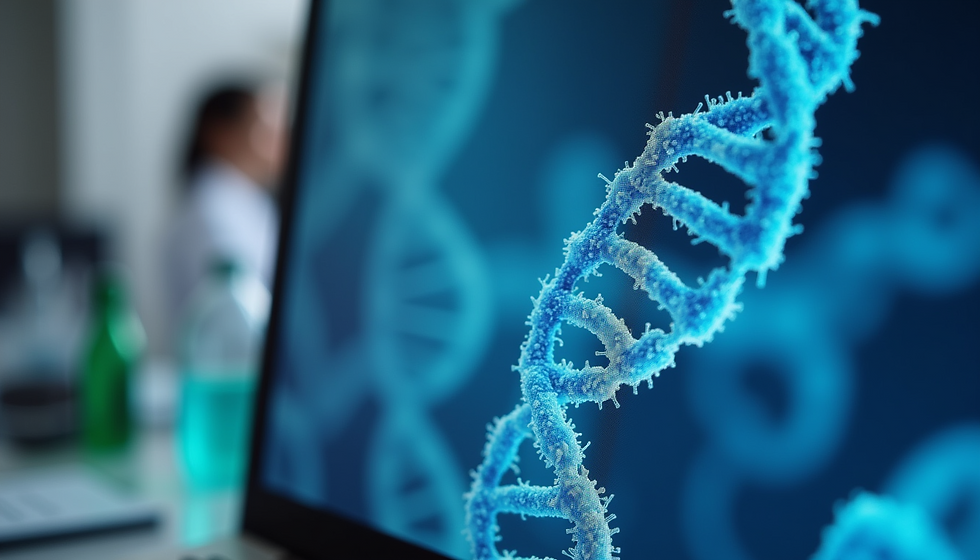The Resurgence of Antibody-Drug Conjugates in Cancer Treatment Key Advances and Insights
- Biotec Maven
- Nov 4
- 4 min read
The fight against cancer is constantly changing as researchers explore new treatments that can improve patients' lives. Among these innovations, Antibody-Drug Conjugates (ADCs) have gained momentum over the last few years. This blog post will dive into what has driven ADCs' comeback, showcasing recent advancements in technology, notable studies, and weighing their benefits and challenges against traditional therapies.
Understanding Antibody-Drug Conjugates
Antibody-Drug Conjugates are targeted cancer therapies that merge the precision of monoclonal antibodies with the effectiveness of cytotoxic drugs. The fundamental idea is simple yet impactful: an antibody is attached to a drug designed to kill cancer cells, enabling targeted delivery and reducing harm to healthy tissue. This approach can significantly improve cancer treatment effectiveness and minimize side effects.
Although ADCs have been in development for decades, their widespread use has been hindered by challenges in design and manufacturing. However, advancements in technology and research are revitalizing interest in this promising treatment approach.
Recent Advancements in Technology and Research
Improved Linker Technologies
One factor driving the resurgence of ADCs is the progress in linker technologies. Linkers are critical because they connect an antibody to its drug. In the past, these linkers were often unstable, causing drugs to be released before reaching the targeted cells.
Recent breakthroughs have produced more robust linkers that remain intact during circulation in the bloodstream. For example, researchers have created linkers that are up to five times more stable than earlier models. This ensures the drug only releases its toxic payload upon binding to cancer cells, drastically improving the safety and effectiveness of ADCs.
Enhanced Antibody Engineering
Advances in antibody engineering have also fueled ADC resurgence. Modern monoclonal antibodies can be designed for improved affinity and specificity for cancer cell antigens.
For example, researchers have developed bispecific antibodies that can attach to two different antigens at once. This capability allows more precise targeting of cancer cells while avoiding healthy cells, further elevating the safety profile of these therapies.
Breakthrough Clinical Trials
Several key studies highlight the effectiveness of ADCs, renewing interest within the oncology field.
One significant example is the FDA approval of trastuzumab emtansine (Kadcyla) for HER2-positive breast cancer. In clinical trials, patients receiving Kadcyla experienced a 50% improvement in progression-free survival compared to those on standard therapies. This success has opened the door for ongoing research into ADCs for other cancer types.
Another groundbreaking development is brentuximab vedotin (Adcetris), designed for CD30 in Hodgkin lymphoma and anaplastic large cell lymphoma. Clinical trials revealed response rates exceeding 75%, affirming ADCs as a promising treatment option for hematologic malignancies.
Potential Benefits of ADCs
Targeted Therapy
One of the most compelling advantages of ADCs is their ability to deliver cytotoxic drugs specifically to cancer cells. This targeted approach limits injury to healthy tissues, leading to reduced side effects commonly seen with traditional chemotherapy.
For instance, studies have shown that nearly 70% of patients receiving ADCs report fewer adverse effects, leading to improved quality of life during treatment. This is especially vital for patients already weakened by their conditions or treatments.
Enhanced Efficacy
ADCs have demonstrated superior efficacy in specific cancer types. By blending the specificity of antibodies with the potency of drugs, ADCs often achieve better tumor response rates.
For example, a study showed complete response rates of around 30% in patients with refractory or relapsed cancers treated with ADCs, a significant improvement over traditional therapies that average only 10% response rates in similar populations.
Combination Therapy Potential
ADCs can also work well with other therapies, such as immunotherapy or targeted agents. This synergistic approach may improve treatment outcomes and overall effectiveness.
For instance, combining ADCs with immune checkpoint inhibitors in early studies has shown a 40% increase in tumor control rates, suggesting that this combo could enhance long-term responses.
Challenges Facing ADCs
Manufacturing Complexities
Despite their promise, ADCs face significant challenges, particularly regarding manufacturing. Creating ADCs involves advanced technology to ensure stable and effective final products.
This complexity can lead to production costs being 30% higher than conventional drugs, potentially limiting access to these therapies for some patients.
Resistance Mechanisms
Like all cancer treatments, ADCs can encounter resistance mechanisms that limit their long-term effectiveness. Cancer cells may adapt, rendering ADCs less effective over time.
Current research is investigating these resistance pathways, aiming to discover combinations that can counteract this issue, such as pairing ADCs with other treatment modalities.
Regulatory Hurdles
The regulatory process for ADCs can also be challenging. As a newer class of therapies, they may undergo stringent scrutiny during the approval stage.
While ensuring they meet safety and efficacy standards is essential, it can delay access for patients who could benefit from these treatments.
Key Studies and Breakthroughs
The Role of Clinical Trials
Clinical trials are crucial for developing and approving ADCs. Recent studies provide vital insights into their effectiveness and safety.
One noteworthy trial is the DESTINY-Breast01, which assessed trastuzumab deruxtecan (Enhertu) in patients with HER2-positive breast cancer who had undergone multiple previous treatments. The trial showed an impressive overall response rate of 60%, leading to its accelerated approval by the FDA.
Future Directions in ADC Research
The future of ADCs is bright, with ongoing studies aimed at broadening their use across various cancer types. Research is focused on identifying novel targets and drug payloads to further boost the therapeutic potential of ADCs.
Moreover, advancements in biomarker identification may help ensure that patients who are most likely to benefit from ADC therapy are selected, helping to improve treatment results.
The Future of ADC Treatment
The resurgence of Antibody-Drug Conjugates in cancer treatment signals a new era in oncology. With improvements in linker technologies, innovative antibody engineering, and encouraging clinical trial results, ADCs are set to become vital in modern cancer therapy.
Though challenges remain, the advantages of ADCs—such as targeted therapy, enhanced effectiveness, and potential for combination with other treatments—mark them as a promising avenue for researchers and patients alike.
As we continue to support research in this area, we enhance the chance for patients to access the most effective and safest treatment options available. The journey of ADCs is just beginning, and their effect on cancer treatment has the potential to be transformative.



Comments